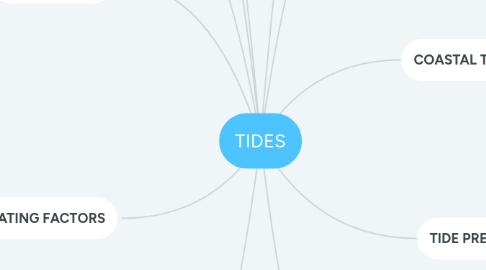
1. DEFINITION
1.1. periodic raising & lowering of sea level
2. TIDAL BULGES
2.1. LUNAR BULGES
2.1.1. One toward moon
2.1.2. One away from moon
2.2. SOLAR BULGES
3. TIDAL PHENOMENA
3.1. TIDAL PERIOD
3.1.1. time between high tides
3.1.2. 12 hours & 25 minutes
3.2. LUNAR DAY
3.2.1. time between two successive overhead moons
3.2.2. 24 hours & 50 minutes
3.3. SOLAR DAY
3.3.1. 24 hours
4. EARTH'S TIDES
4.1. FLOOD TIDE
4.1.1. water moves toward shore
4.2. EBB TIDE
4.2.1. water moves away from shore
5. COMPLICATING FACTORS
5.1. DECLINATION
5.1.1. angular distance of the moon or sun above or below earth's equator
5.2. UNEQUAL TIDES
5.2.1. lunar & solar bulges shift from equator
5.3. ELLIPTICAL ORBITS
5.3.1. EARTH AROUND SUN
5.3.1.1. PERIHELION
5.3.1.1.1. greatest tidal range (January)
5.3.1.2. APHELION
5.3.1.2.1. least tidal range (July)
5.3.2. MOON AROUND EARTH
5.3.2.1. PERIGEE
5.3.2.1.1. greatest tidal range
5.3.2.1.2. moon closest to earth
5.3.2.2. APOGEE
5.3.2.2.1. least tidal range
5.3.2.2.2. moon furthest from earth
5.3.3. PROXIGEAN TIDES
5.3.3.1. spring tide + perigee
5.3.3.2. exceptionally high tidal range
5.3.3.3. every 1.5 years
6. TIDAL PATTERNS
6.1. DIURNAL
6.1.1. one high tide/one low tide per day
6.2. SEMIDIURNAL
6.2.1. two high tides/two low tides per day
6.2.2. same tidal range
6.3. MIXED
6.3.1. two high tides/two low tides per day
6.3.2. different tidal range
6.3.3. most common
7. GRAVITATIONAL FORCES
7.1. MOON
7.1.1. ZENITH
7.1.1.1. greatest force & closest to the moon
7.1.2. NADIR
7.1.2.1. least force & furthest from the moon
7.2. SUN
8. MONTHLY TIDAL CYCLE
8.1. TIDAL RANGE
8.1.1. difference between high & low tides
8.2. SPRING TIDES
8.2.1. NEW MOON
8.2.1.1. moon between earth & sun
8.2.2. FULL MOON
8.2.2.1. earth between sun & moon
8.2.3. SYZYGY
8.2.3.1. allignment of moon, earth & sun
8.2.4. greatest tidal range
8.3. NEAP TIDES
8.3.1. QUARTER MOONS
8.3.1.1. moon appears half lit
8.3.2. QUADRATURE
8.3.2.1. moon in first or third quarter phase
8.3.3. least tidal range
9. TIDE PREDICTION
9.1. two high tides per day
9.2. two low tides per day
9.3. six lunar hours between high & low tides
10. COASTAL TIDES
10.1. STANDING WAVES
10.1.1. tide waves reflected by coast
10.1.2. amplification of tidal range
10.2. BAY OF FUNDY
10.2.1. in Nova Scotia
10.2.2. world's largest tidal range
10.3. TIDAL BORES
10.3.1. tide-generated wall of water
11. COASTAL TIDAL CURRENTS
11.1. ROTARY CURRENT
11.1.1. accompanies the slowly turning tide crest in a Northern Hemisphere basin
11.1.2. rotates counterclockwise
11.2. REVERSING CURRENT
11.2.1. alternating current
11.2.2. moves in & out of narrow coastal passages
11.3. FLOOD CURRENT
11.3.1. water rushes up a bay or river with incoming tide
11.4. EBB CURRENT
11.4.1. water drains from bay or river as tide goes out
11.5. HIGH SLACK WATER
11.5.1. peak of each high tide with no current motion
11.6. LOW SLACK WATER
11.6.1. peak of each low tide with no current motion
11.7. WHIRLPOOL
11.7.1. rapidly spinning seawater
11.7.2. restricted channel connecting two basins with different tidal cycles
